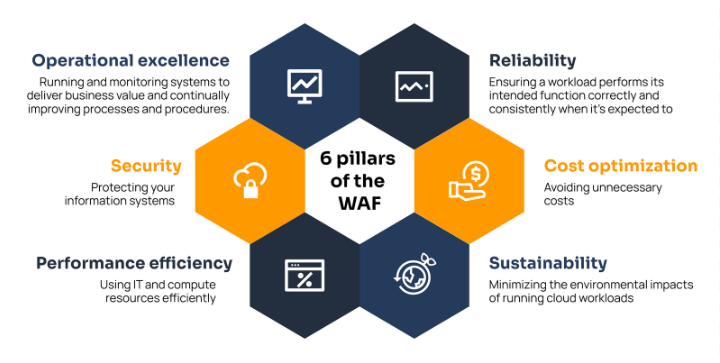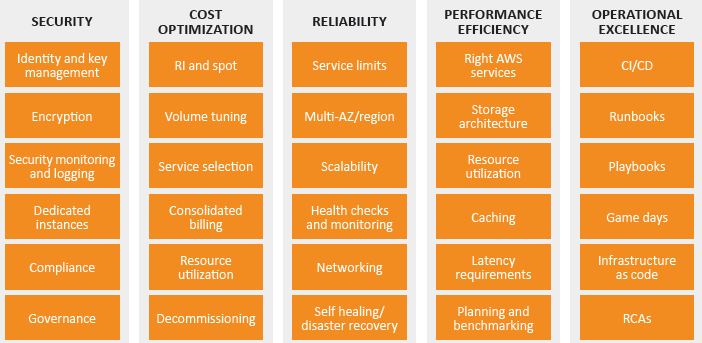Mastering AWS Cloud Architecture: A Comprehensive Guide to the Well-Architected Framework

The AWS Well-Architected Framework is a comprehensive guide for building secure, reliable, efficient, and cost-effective systems on the AWS cloud. It provides a consistent approach to evaluate your architecture against best practices and identify areas for improvement. In this guide, we'll look into advanced concepts, technical details, and specific use cases that highlight how to implement the framework effectively.
Core Principles

Six Pillars:
- Operational Excellence:
- Streamline Operations: Implement infrastructure as code (IaC) using AWS CloudFormation or Terraform to automate and standardize deployments.
- Monitoring and Logging: Use AWS CloudWatch for monitoring and centralized logging to gain insights and automate responses to operational events.
- Incident Management: Implement automated incident response and root cause analysis with AWS Systems Manager and AWS Config.
- Security:
- Identity and Access Management: Use AWS IAM, AWS Organizations, and AWS SSO for granular access control and centralized account management.
- Data Protection: Encrypt data at rest with AWS KMS and in transit with TLS. Implement data classification and protection policies.
- Infrastructure Security: Leverage AWS Shield, AWS WAF, and AWS Firewall Manager for DDoS protection, web application firewalling, and centralized security management.
- Detective Controls: Use AWS GuardDuty, AWS Config, and AWS CloudTrail for continuous monitoring and logging of activities.
- Reliability:
- Foundational Requirements: Ensure a well-architected foundation with properly configured IAM roles, VPCs, and multi-AZ deployments.
- Failure Management: Implement AWS Elastic Load Balancer and Auto Scaling to handle load distribution and automatic recovery.
- Disaster Recovery (DR): Design DR strategies such as pilot light, warm standby, or active-active with services like AWS Backup and AWS Route 53.
- Performance Efficiency:
- Selection of Right Resources: Choose appropriate instance types, database solutions (e.g., RDS, DynamoDB), and storage solutions (e.g., S3, EFS).
- Monitoring Performance: Use AWS CloudWatch and AWS X-Ray for performance monitoring and tracing.
- Load Testing: Conduct regular load and performance tests using AWS CloudFormation or third-party tools to validate scaling policies and resource limits.
- Cost Optimization:
- Cost Management and Monitoring: Use AWS Cost Explorer and AWS Budgets to monitor spending and set cost alerts.
- Right-Sizing Resources: Regularly review and adjust resource types and sizes, using tools like AWS Compute Optimizer.
- Utilize Pricing Models: Leverage Reserved Instances, Spot Instances, and Savings Plans for cost savings.
- Resource Efficiency: Implement resource tagging and AWS Trusted Advisor recommendations for identifying underutilized resources.
- Sustainability:
- Sustainable Design: Architect for energy efficiency by optimizing compute and storage usage.
- Resource Efficiency: Leverage serverless technologies (e.g., AWS Lambda, AWS Fargate) and managed services to reduce infrastructure overhead.
- Monitoring and Reporting: Track and report on sustainability metrics using AWS CloudWatch and AWS Sustainability Insights.
Trade-offs and Prioritization:
- Context-Specific Decisions: Balance the six pillars based on specific business needs, such as prioritizing cost in a development environment or reliability for mission-critical applications.
- Architectural Trade-offs: Understand and document trade-offs between latency, consistency, and cost for data storage and processing.
Using the Framework

Foundational Questions:
- Assessment: Use the framework's questions to evaluate your architecture against each pillar. Identify potential weaknesses and areas for improvement.
- Regular Reviews: Conduct regular architectural reviews using the AWS Well-Architected Tool to stay aligned with best practices.
Best Practices:
- Comprehensive Guidance: Access AWS’s extensive library of best practices, including detailed whitepapers, blogs, and architectural blueprints.
- Pattern Implementation: Apply design patterns such as microservices, event-driven architectures, and serverless computing based on specific use cases.
The Well-Architected Tool:
- Automated Reviews: Utilize the Well-Architected Tool for automated architecture reviews, risk identification, and improvement recommendations.
- Actionable Insights: Generate detailed reports and actionable insights for continuous improvement.
Use Cases
Scenario 1: E-commerce Website
- Focus: Performance Efficiency and Scalability.
- Well-Architected Principles Followed:
- Operational Excellence: Automated deployment pipelines with AWS CodePipeline and AWS CodeDeploy.
- Security: Implement IAM roles with least privilege and use AWS WAF to protect against common web exploits.
- Reliability: Use AWS Auto Scaling to handle traffic spikes during sales or peak seasons.
- Performance Efficiency: Use AWS CloudFront for caching and reducing load on origin servers.
- Cost Optimization: Use AWS Compute Optimizer to right-size instances and AWS Budgets for cost monitoring.
- Sustainability: Implement serverless functions with AWS Lambda for handling non-critical background tasks.
Scenario 2: Big Data Analytics Platform
- Focus: Cost Optimization and Security.
- Well-Architected Principles Followed:
- Operational Excellence: Use AWS Glue for ETL processes and AWS Step Functions for orchestrating workflows.
- Security: Encrypt data at rest and in transit using AWS KMS and enforce strict access controls with IAM policies.
- Reliability: Utilize Amazon S3 for durable storage and ensure backup with AWS Backup.
- Performance Efficiency: Leverage Amazon Redshift for scalable data warehousing and AWS Athena for ad-hoc querying.
- Cost Optimization: Use Spot Instances for cost-effective compute resources and enable Amazon S3 Intelligent-Tiering.
- Sustainability: Use AWS Glue for managed ETL processes to reduce infrastructure overhead.
Scenario 3: Disaster Recovery Solution
- Focus: Reliability and Availability.
- Well-Architected Principles Followed:
- Operational Excellence: Implement AWS Systems Manager for configuration management and automation.
- Security: Use IAM roles and policies for secure access to DR resources.
- Reliability: Deploy a multi-AZ architecture with automatic failover using Amazon RDS and Amazon Route 53.
- Performance Efficiency: Use Amazon CloudWatch for monitoring and AWS Lambda for automating failover processes.
- Cost Optimization: Optimize resource usage with AWS Cost Explorer and leverage Reserved Instances for critical DR resources.
- Sustainability: Implement automated shutdown of non-essential DR resources during non-peak hours.
Advanced Concepts
- Infrastructure as Code (IaC):
- Automated Deployments: Use AWS CloudFormation, Terraform, or AWS CDK to define and provision infrastructure in a repeatable and automated manner.
- CI/CD Pipelines: Implement CI/CD pipelines with AWS CodePipeline and AWS CodeBuild for automated deployments and testing.
- Serverless Architectures:
- Scalable Functions: Use AWS Lambda, AWS Fargate, and Amazon API Gateway to build highly scalable and cost-effective serverless applications.
- Event-Driven Architectures: Implement event-driven architectures with Amazon EventBridge and AWS Step Functions.
- Machine Learning and AI:
- Model Deployment: Leverage AWS SageMaker for building, training, and deploying machine learning models.
- AI Integration: Utilize AWS Rekognition, AWS Comprehend, and AWS Lex for integrating AI capabilities into applications.
- Data Lakes and Analytics:
- Data Lakes: Implement data lakes with AWS Lake Formation, Amazon S3, and AWS Glue.
- Analytics: Use Amazon Redshift and Amazon Athena for large-scale data analytics and querying.
- Multi-Region Deployments:
- Global Applications: Design multi-region architectures for global applications with services like Amazon Route 53, AWS Global Accelerator, and AWS CloudFront.
- Data Replication: Ensure data replication and failover strategies with Amazon S3 Cross-Region Replication and AWS Database Migration Service.
Benefits of Using the Framework
- Improved Architecture:
- By following best practices, build more secure, reliable, and efficient systems.
- Reduced Costs:
- Optimize architecture to avoid unnecessary spending on AWS services through continuous monitoring and optimization.
- Increased Agility:
- Design for scalability and rapid adaptation to changing business needs, enabling quicker response to market demands.
- Better Decision-Making:
- Use a structured approach to evaluate architecture, identify trade-offs, and prioritize improvements, leading to more informed decisions.
By adhering to the AWS Well-Architected Framework, organizations can ensure their cloud architectures are robust, cost-efficient, and capable of meeting their business objectives effectively while leveraging advanced AWS services and best practices. This guide serves as a detailed roadmap to mastering cloud architecture on AWS, making your systems more secure, scalable, and cost-effective.
Happy Clouding !!!
Did you like this post?
If you did, please buy me coffee 😊